Generally, the peperomia varieties are different from one to the next, making it challenging to discern whether they are within the same family.
Regardless of the variety, all peperomia plants require a little maintenance; they are slow-growing and can be grown all year long. Keep reading to find the most popular peperomia varieties, including their characteristics and which one is better for your garden.
See also: 9 Best Succulents That Grow Well In Dark Room.
11- Peperomia Varieties, including their characteristics
The most widely cultivated peperomia variety in the United States is Peperomia obtusifolia, according to the University of Florida. Below is a list of the most commonly grown Peperomia types:
1- Watermelon Peperomia (AKA Peperomia Argyreia)
With its stunning watermelon-patterned foliage, watermelon peperomia (also known as Peperomia argyreia) is one of the most popular houseplant lovers.
Watermelon peperomia is the most favored peperomia variety among gardeners. Its small size makes it perfect for windowsills and desktops as it will not block light.
Peperomia argyreia requires sun exposure and a rich, compost-based potting mix to thrive. It’s an excellent choice for an office or cubicle.
plantsheaven.com
Watermelon peperomia grows abundantly in hanging baskets and when planted on the soil. It has dark green leaves with splashes of red and pink, which gives it a watermelon effect, mainly when grown in clusters.
Watermelon peperomia prefers medium lighting but can also succeed in semi-shade. The table below shows the characteristics of Watermelon peperomia.
| Genus name | Pilea argyreia |
| Family | Piperaceae (pepper family) |
| Commonly known as | – Watermelon begonia – Watermelon peperomia |
| Plant Type | Perennial |
| Light Requirements | Prefer partial sun exposure (bright light or indirect) |
| Soil requirement | Thrive in moist and well-drained soil |
| Maintenance requirement | Easy |
| pH requirements | Acidic |
| Flower Color | Green |
| Hardiness Zones | 10 to 12 |
| Watering requirements | – When grown indoors: sprinkle it with water once a week – When grown outdoors: Only water it every two weeks. |
| Propagation | – Stems – Cuttings – Avoid overwatering your new plant, particularly during its first few weeks. |
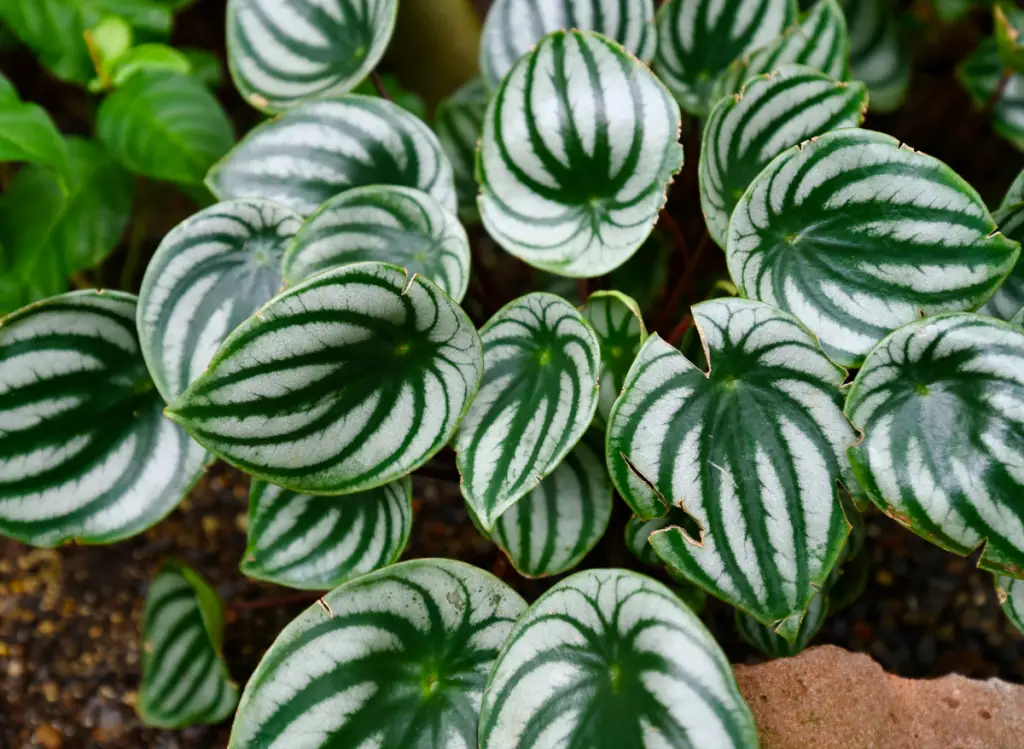
2- Baby Rubber Plant (AKA Peperomia Obtusifolia)
If you are looking for indoor plants for your office, the baby rubber plant is a good choice as its leaves aren’t messy compared to some larger peperomia houseplants.
Peperomia obtusifolia and its cultivars are among the most cultivated varieties of Peperomia grown in the United States.
University of Florida
The below table outlines the characteristics of Peperomia obtusifolia to ensure that you provide your Peperomia with the appropriate balance of nutrition and care throughout its life.
| Genus name | Peperomia |
| Family | Piperaceae (pepper family) |
| Commonly known as | – Peperomia Obtusifolia – Baby Rubber Plant – American Rubber Plant – Pepper Face Plant |
| Plant Type | – Herbaceous – Perennial – Houseplant – Poisonous (can be toxic to some animals) |
| Light Requirements | Thrive in direct sunlight with 2 to 6 hours of sunlight or partial shade. |
| Soil requirement | Prefers moist and well-drained soil. |
| Maintenance requirement | Low |
| Soil pH requirements | Neutral (6.0 to 8.0) |
| Flower Color | – Cream – Tan – White |
| Hardiness Zones | 10 to 12 |
| Watering requirements | – Spray it with water two to three times a week when grown outdoors. – When kept indoors, only water once every couple of weeks |
| Plant size | The average height of the baby rubber plant is 10 inches. |
| Propagation | – Stem cutting – Leaf cutting |
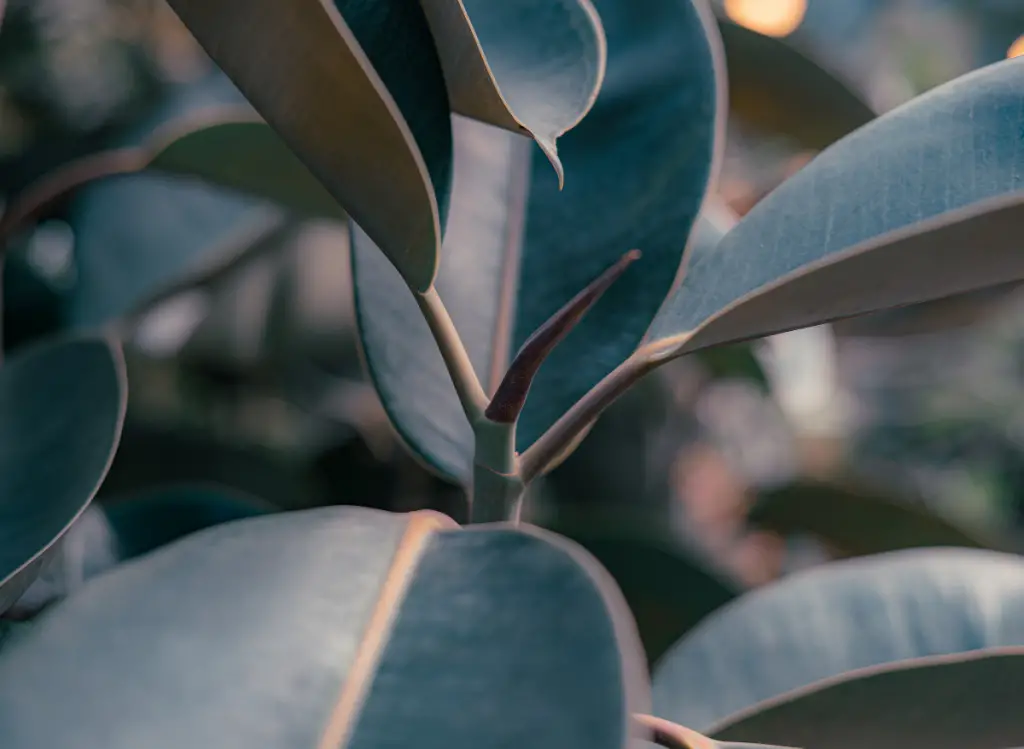
3- String of Turtles (Peperomia Prostrata)
String of Turtles (AKA Peperomia prostrata) is a small succulent native to Brazilian rainforests thriving in warm climates and acclimates well to average household conditions. This makes string of turtles Peperomia plant among the most popular peperomia varieties.
String of turtles is a good choice if you have limited space, particularly in the office, cubicles, or houses.
plantsheaven.com
No matter where you plant it, the uniqueness of Peperomia prostrata will elevate the beauty of your space or office.
The table below shows the characteristics of String of Turtles plant:
| Genus name | Peperomia prostrata |
| Commonly known as | String of Turtles |
| Family | Piperaceae (pepper family) |
| Sun Exposure | Thrive in bright and indirect light |
| Soil requirements | Peperomia prostrata grow well in a moist and loamy soil |
| pH requirement | Neutral to acidic |
| Plant type | Semi-succulent |
| Plant Size | 12 inches long |
| Hardiness Zones | 10 to 12 |
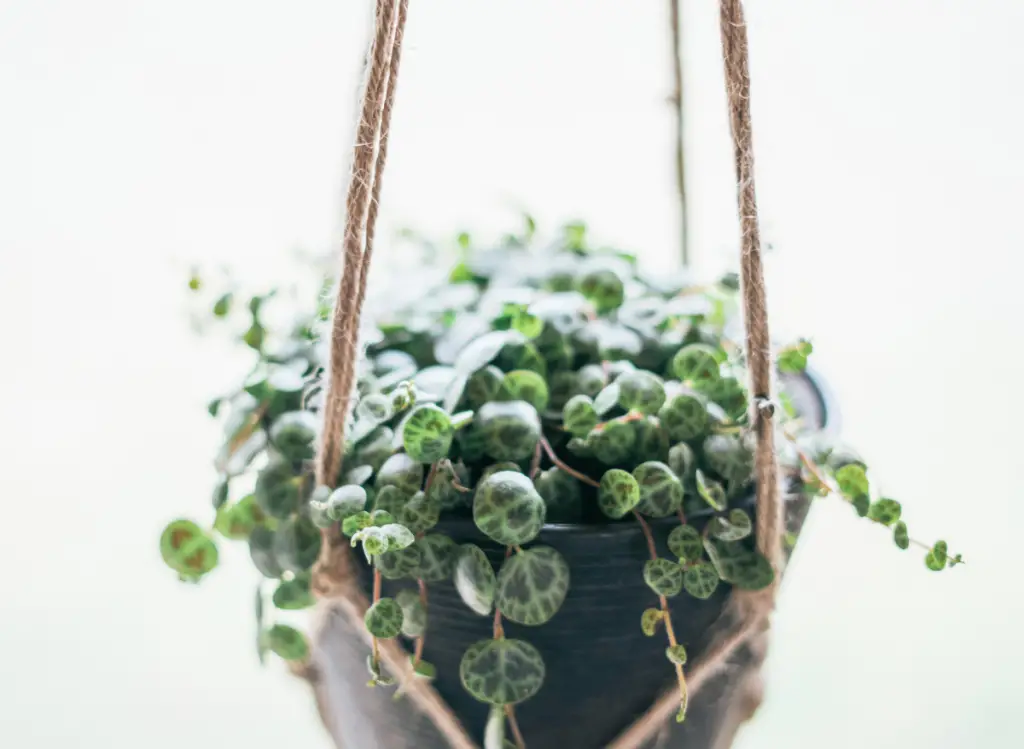
4- Peperomia Hope (AKA Peperomia Tetraphylla)
Peperomia Hope is a blend of two different Peperomia plants, earning the name Peperomia deppeana×quadrifolia.
Peperomia Hope originates from Central and South America and prefers higher water and humidity levels.
Before watering Peperomia tetraphylla:
- Pinch the top 1-inch (2.54 cm) of the soil to check if it is scorched
- A watering cycle of 7 to 10 days is generally sufficient.
The table below displays Peperomia Hope’s characteristics to ensure that you provide your plant with the appropriate balance of care and nutrition throughout its life.
| Genus name | Peperomia |
| Family | Piperaceae (pepper family) |
| Commonly known as | – Acorn peperomia – Four-leaved peperomia |
| Plant Type | Perennial |
| Light Requirements | Even though peperomia tetraphylla grow best in bright indirect light, ensure you protect your plant from direct rays. |
| Soil requirement | Peperomia tetraphylla thrives in a well-drained and very porous, preferably a soil mix dense in organic nutrients. |
| Maintenance requirement | Medium to low |
| Soil pH requirements | 6 to 6.6 |
| Temperature requirements | Peperomia tetraphylla does well in temperatures between 65° and 75ºF (18° – 24°C). |
| Hardiness Zones | 10 to 12 |
| Watering requirements | Even though Peperomia tetraphylla plants prefer moisture, they can also endure drought. However, they will not tolerate waterlogging. |
| Plant size | 8 to 12 inches (25.4 to 30.48 cm) high. |
| Propagation | – Stem cutting – Leaf cutting |
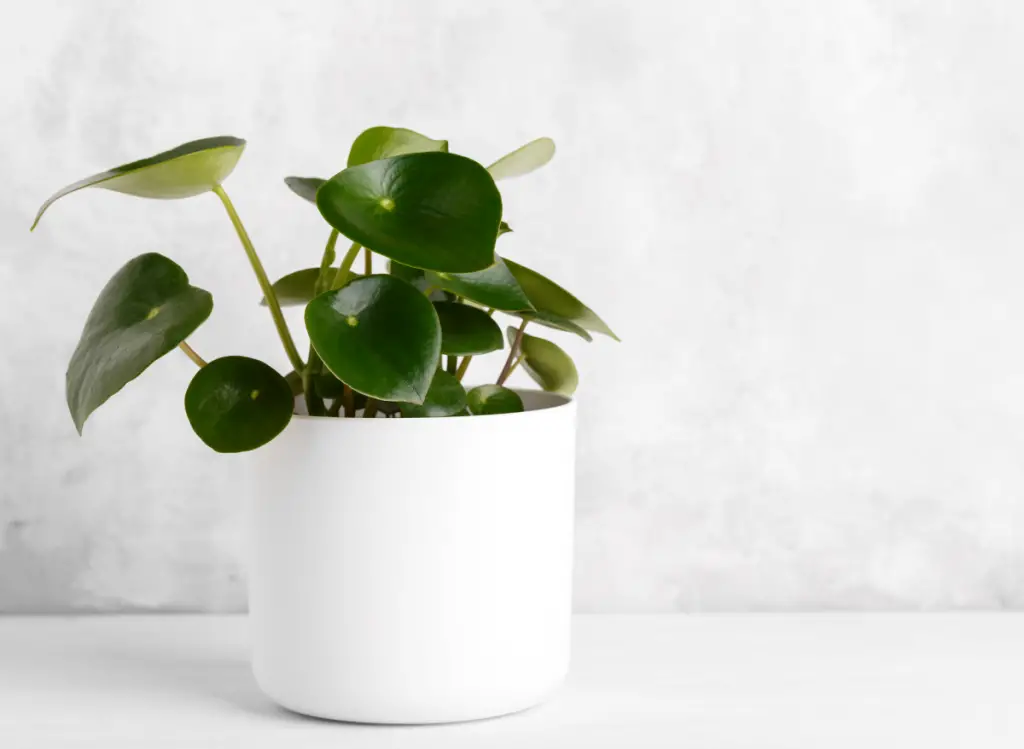
5- Red Ripple Peperomia (AKA Peperomia caperata)
Red Ripple Peperomia (AKA Peperomia caperata) is an evergreen perennial in the Piperaceae family. It is often grown as a houseplant for its succulent heart-shaped, crinkled, and deeply veined leaves.
Red Ripple Peperomia grows best when attached to something, including a hanging basket or piece of driftwood.
plantsheaven.com
Red ripple Peperomia performs well with bright fluorescent lights, making it ideal for offices. And it has no serious pest or disease problems.
The table below shows the characteristics of Red ripple Peperomia (AKA Peperomia caperata).
| Genus name | Peperomia |
| Family | Piperaceae (pepper family) |
| Commonly known as | – Emerald ripple peperomia – Silver heart – Emerald ripple pepper – Little fantasy peperomia – Green ripple peperomiaIvy-leaf peperomia – Ripple peperomia – Metallic peperomia |
| Plant Type | – Perennial – Ground cover |
| Light Requirements | – Dappled sunlight – Partial shade – Direct sunlight with 2 to 6 hours of sun exposure |
| Soil requirement | Red ripple Peperomia thrives in well-drained and porous potting soil. |
| Maintenance requirement | Easy to maintain |
| Soil pH requirements | 6.0 to 6.6 |
| Flower Color | – Copper – Brown – Yellow – Gold |
| Hardiness Zones | 9 to 11 |
| Temperature requirements | 65 to 75℉ (18 to 24℃) |
| Watering requirements | – In spring, water once a week and every 2 to 3 weeks in winter. – Water when the top 4 to 5 inches of soil is dry |
| Plant size | 8 inches (20.32 cm) |
| Propagation | – Division – Root cutting – Leaf cutting |
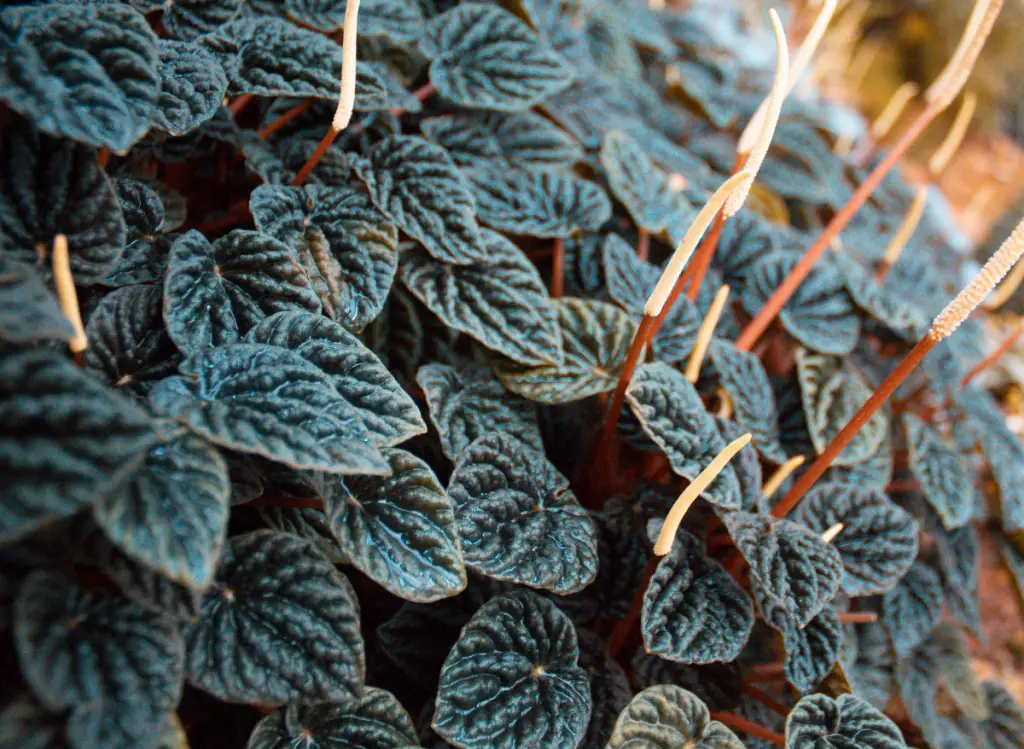
6- Peperomia Belly Button or Red Log (AKA Peperomia Verticillata)
Peperomia Verticillata is one of the more vibrant plants within the Peperomia family, with rich red and green leaves.
The deep colors of its foliage make it an ideal plant for color matching in your home. It is moderately easy to take care of and doesn’t grow too big, making an excellent plant for decorating an office or keeping on your nightstand.
plantsheaven.com
Peperomia belly button, also known as Peperomia verticillata, is a beautiful plant that you can grow with minimum care, as it does not require much water or feeding. They get the name red log because of the red shading underneath their leaves.
Peperomia typically are perennial plants, and many people tend to grow them because of their ornamental leaves and unique foliage.
Check the table below to find out the characteristics of Peperomia belly button.
| Genus name | Peperomia |
| Family | Piperaceae (pepper family) |
| Commonly known as | – Vein Leaf Peperomia – Red Log |
| Plant Type | Perennial |
| Light Requirements | – Thrives in partial shade. – Try placing your plant in a bright room or directly in a south-facing window. |
| Soil requirement | Rich and well-drained soil |
| Maintenance requirement | Low |
| Soil pH requirements | 5.0 to 7.0 |
| Flower Color | Showy |
| Hardiness Zones | 10 to 12 |
| Temperature requirements | Minimum 41 F ( 5 Celsius) |
| Watering requirements | – Ensure you let the soil dry out between waterings as Peperomia belly button plants don’t like to be overwatered. – About 2 inches of your soil should be dry before watering water again. – Remember to water the soil evenly. |
| Plant size | 11.82 inches (30 cm) |
| Propagation | In spring or summer, you can propagate Peperomia belly button by: – Division – Seed – Leaf – Or stem cuttings. |
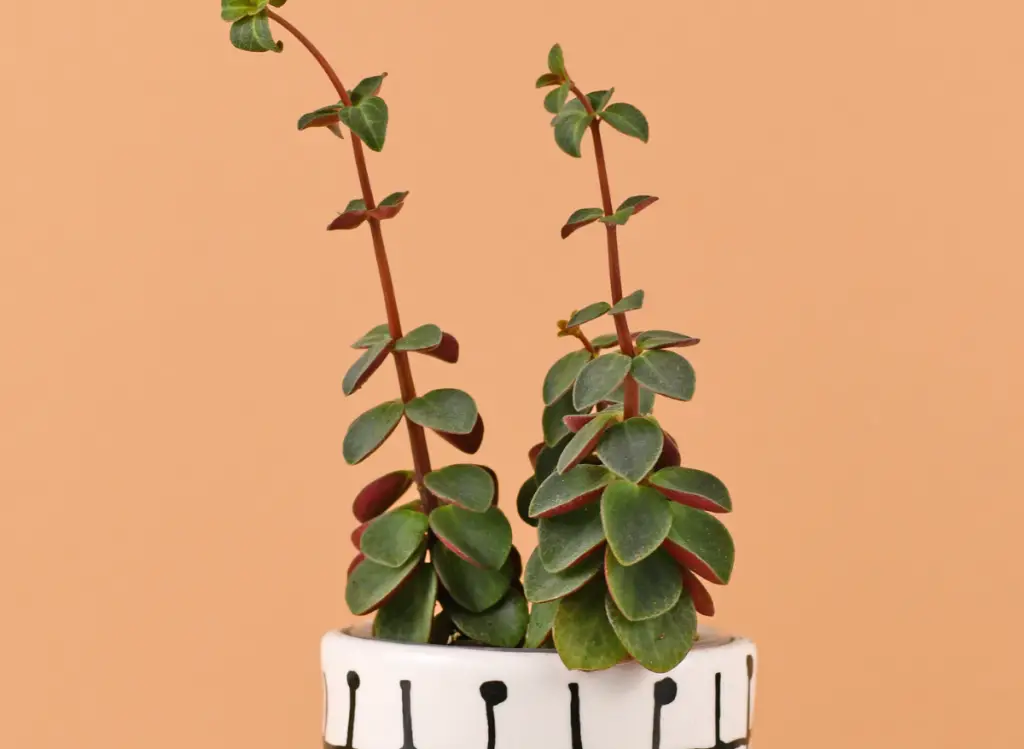
7- Peperomia Obtusifolia Variegata (AKA Variegated Baby Rubber Plant)
Peperomia obtusifolia Variegata is an evergreen, perennial, and fast growth with shiny fleshy leaves.
It makes a long-lasting houseplant and will cascade over the side of a hanging basket. It also grows well in a container culture or in raised planters.
Peperomia obtusifolia is one of the easiest species to grow.
Rutgers, the State University of New Jersey.
The table below shows the characteristics of the Baby rubber plant (AKA Peperomia Obtusifolia)
| Genus name | Peperomia |
| Family | Piperaceae (pepper family) |
| Commonly known as | – Pepper face – Baby rubber plant – Blunt Leaved Radiator Plant – Baby Rubber Tree – Pepper face – Baby rubber plant – Blunt Leaved Radiator Plant – Baby Rubber Tree |
| Plant Type | – Herbaceous – Perennial |
| Light Requirements | Peperomia obtusifolia grows in partial to deep shade |
| Soil requirement | – Baby rubber plants thrive in moist, rich, organic, or less fertile sandy soils. – It prefers slightly alkaline, sandy, clay, acidic, and loamy soil. |
| Maintenance requirement | Requires minimal maintenance |
| Soil pH requirements | Between 5.5 and 7.0 |
| Flower Color | – White – Baby rubber plant flowers occasionally throughout the year |
| Hardiness Zones | 10 to 11 |
| Temperature requirements | Thrives in between 65 to 80 degrees Fahrenheit (18 to 27 Celcius) |
| Watering requirements | – Water your baby rubber plant every 1 to 2 weeks and allow the potting soil to dry out between waterings. – In brighter light, the baby rubber plant requires frequent watering, and in lower light, it needs watering less frequently. |
| Plant size | 9.84 to 11.811inches (25 to 30 cm) tall |
| Propagation | – Root cutting – Leaf cutting |
| Origin | South America |
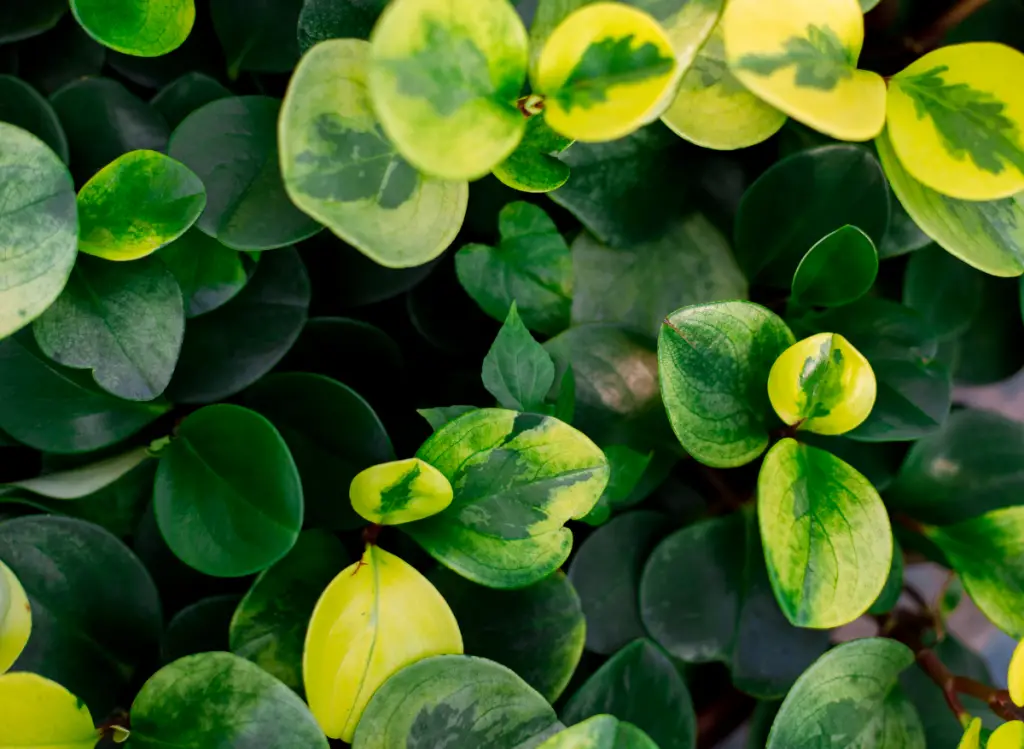
8- Peperomia Caperata (AKA Tricolor Peperomia)
The Peperomia caperata “Tricolor” is among my favorites plants in terms of aesthetics. It has bright variegated leaves with light green, red, and white colors.
Ensure the temperature does not drop below 50° degrees Fahrenheit (10° C) as cold breezes from doors and windows may harm your plant, causing its leaves to droop.
Water tricolor peperomia plant moderately during its growing season, ensuring moist soil remains.
The best way to water tricolor peperomia is to water the plant from below to provide the root system with the right amount of water needed without overwatering the leaves and stems.
plantsheaven.com
The table below outlines the characteristics of Peperomia caperata to make sure that you provide your Peperomia with the proper balance of nutrition and care throughout its life.
| Genus name | Peperomia |
| Family | Piperaceae (pepper family) |
| Commonly known as | – Peperomia ginny – Rainbow peperomia – Peperomia jelly – Variegated red edge peperomia – Peperomia tricolor – Radiator plant |
| Plant Type | – Ground covers – Houseplants – Perennials |
| Light Requirements | – Partly shaded to direct sunlight exposure (Between 2 to 6 hours daily). – Tricolor Peperomia thrives in full sun or partial shade. – Keep in mind that direct sunlight may burn its leaves. |
| Soil requirement | Thrives in sandy to loamy soil |
| Maintenance requirement | Low maintenance |
| Soil pH requirements | Between 5 to 7.5 |
| Flower Color | White |
| Hardiness Zones | 10 to 11 |
| Temperature requirements | Does well in between 65 to 80 degrees Fahrenheit (about 18 to 27 Celcius) |
| Watering requirements | Moderate, irregular watering to allow the top 50-75% of the soil to dry before watering again. |
| Plant size | 6 to 8.04 inches ( 15.24 to 20.42 cm) |
| Propagation | – Division – Root cutting – Leaf cutting |
| Origin | West Indies and Venezuela |
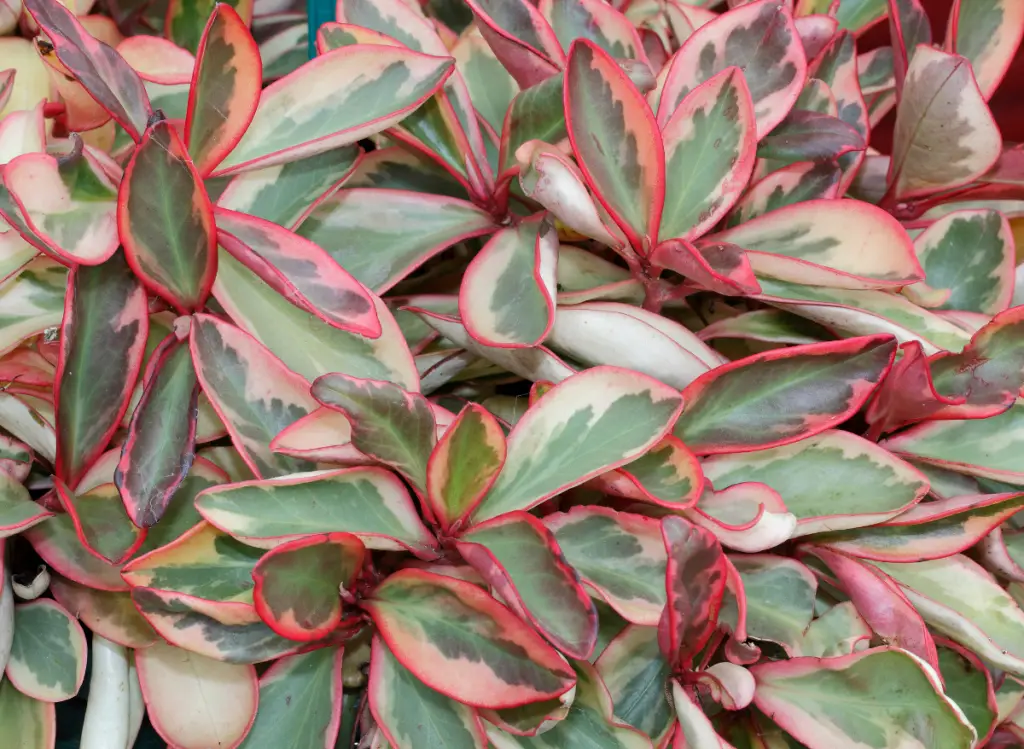
9 – Metallic Peperomia (Peperomia Rosso)
Peperomia Metallica is an evergreen perennial with succulent, leathery, metallic-looking leaves and heart-shaped foliage.
The leaves are dark green-black with a silver-green streak down the center and contrasting red undersides. Peperomia Metallica produces small flowers on spikes above the foliage.
The Metallic peperomia is an excellent choice for beginners as it requires low maintenance.
plantsheaven.com
Metallic peperomia can add color to your home or office, making it houseplant an excellent choice for use in hanging baskets.
The below table shows all the characteristics of Peperomia metallic or Peperomia Rossoto to ensure proper and healthy growth.
| Genus name | Peperomia |
| Family | Piperaceae (pepper family) |
| Scientific name | Peperomia rosso |
| Commonly known as | – Peperomia Eden rosso – Peperomia Caperata rosso |
| Plant Type | Perennial plant |
| Light Requirements | Thrives in bright indirect sunlight |
| Soil requirement | – Metallic peperomia prefers a moist environment and thrives in well-draining, neutral, or acidic soil. – Before watering, allow the soil to dry out |
| Maintenance requirement | Require very little maintenance |
| Soil pH requirements | Between 6 to 6.6 |
| Flower Color | – Dull brown – Yellow |
| Hardiness Zones | 10 to 11 |
| Temperature requirements | Grows well in warm temperatures, between 60°F to 77°F. (16 to 25 celsius) |
| Watering requirements | – In spring, aim to water once per week – In winter, every 2 to 3 week |
| Plant size | – Indoor, up to 10 inches (25.4 cm) tall – Up to 36 inches (91 cm) outdoors (as a trailing plant) |
| Propagation | – Division – Root cutting – Leaf cutting |
| Origin | South America |
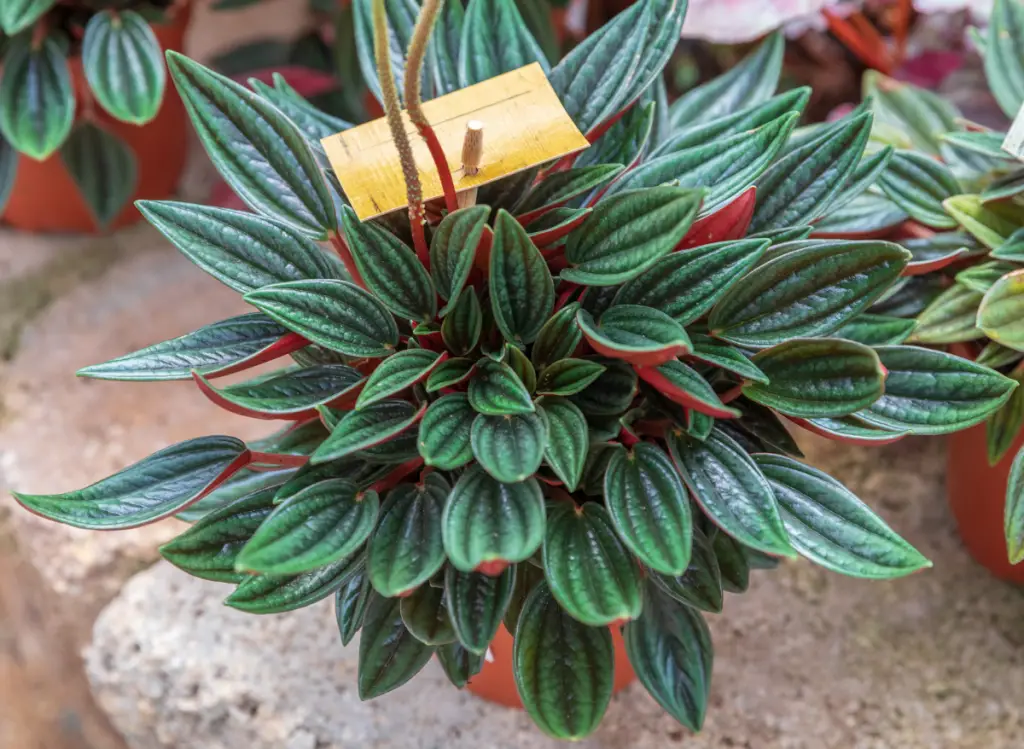
10- Ruby Glow (AKA Peperomia Graveolens)
Ruby Glow, also known as Peperomia graveolens is a particularly unique-looking plant with large, thick leaves varying in color from light green to dark purple depending on the amount of sunlight it receives throughout its growing season.
Ruby Glow needs abundant sunlight, good drainage, and infrequent water to prevent rot. Choose containers with drainage holes and well-draining soil with about 50% to 70% mineral grit, including coarse sand, pumice, or perlite.
plantsheaven.com
Generally, peperomia graveolens will not survive a harsh frost, but if you suspect a risk of temperatures dropping, you can bring them indoors to grow on a sunny window sill or under a grow light.
Check out the below table to find out the favorable growth conditions of Ruby Glow (AKA peperomia graveolens).
| Genus name | Peperomia |
| Family | Piperaceae (pepper family) |
| Scientific name | Peperomia graveolens |
| Commonly known as | – Ruby Glow – Ruby Glow Peperomia – Ruby Peperomia |
| Plant Type | – Perennial houseplant – Ornamental – Succulent |
| Light Requirements | – Bright indoor light – Filtered or partial sun exposure |
| Soil requirement | – Ruby Glow prefers moist, well-draining, humus-rich peat-based or well-draining soil. – When growing indoors, choose a pot with drainage holes. |
| Maintenance requirement | It is a low maintenance plant |
| Soil pH requirements | – Neutral – Slightly Acidic |
| Flower Color | Whitish-yellow |
| USDA Hardiness Zones | 10 to 11 |
| Temperature requirements | Peperomia graveolens thrive in temperatures between 65° to 75° degrees Fahrenheit (18 °C and 24° C) |
| Watering requirements | Water deep enough to run out the drainage hole, and then wait for the soil to dry before thoroughly watering. |
| Plant size | 9 to 12 inches (23 to 30 cm) |
| Propagation | Easy to propagate from stem cuttings |
| Origin | Forest understories of the Ecuadorian Andes |
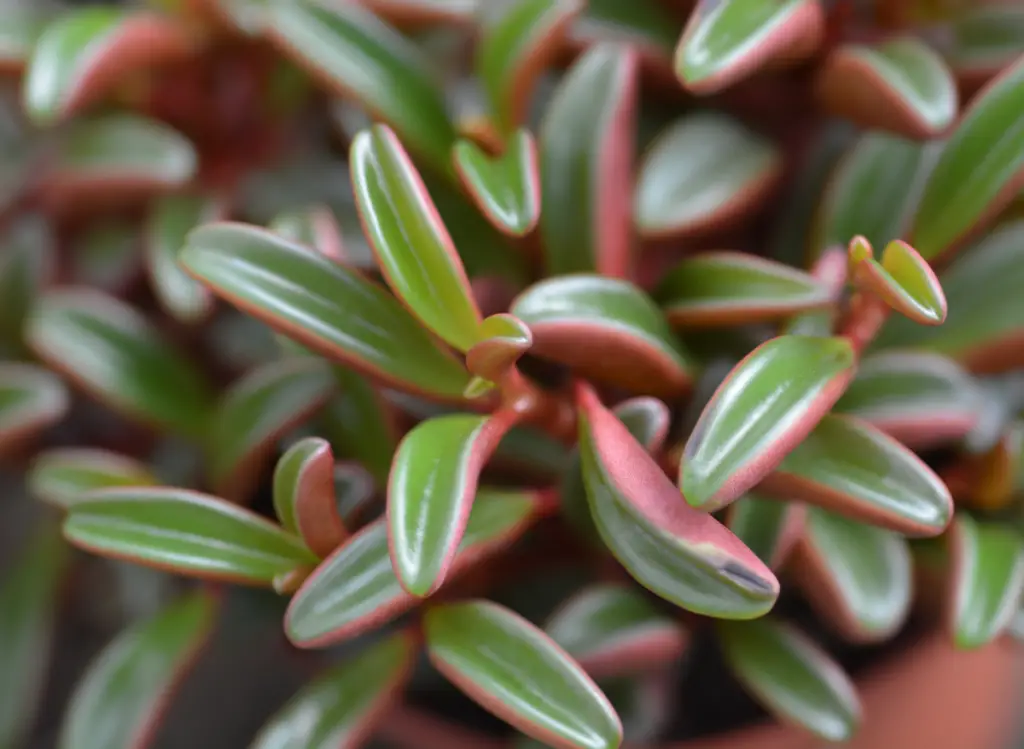
11- Jayde Peperomia (Peperomia Polybotrya)
Peperomia Jayde or Peperomia Raindrop, also referred to as Peperomia Polybotrya, is a dark green, heart-shaped, succulent leaves that grow upright, similar to the “Pancake plant.”
Peperomia Jayde is also generally called Coin Leaf Peperomia because of its thick, coin-like leaves.
Peperomia polybotrya is great for smaller spaces, including offices or homes as it remains pretty compact.
plantsheaven.com
The below table outlines the characteristics of Jayde Peperomia (Peperomia polybotrya) to ensure that you provide your plant the proper balance of nutrition and care throughout its life
| Genus name | Peperomia |
| Family | Piperaceae (pepper family) |
| Scientific name | Peperomia Polybotrya |
| Commonly known as | – Coin Leaf Peperomia – Peperomia graveolens – Peperomia Raindrop |
| Plant Type | – Perennial houseplant – Succulent – Ornamental |
| Light Requirements | – Planted outdoor, Jayde Peperomia likes morning sun and afternoon shade. – Indoors, place Jayde Peperomia in bright indirect sunlight or a south-facing window. |
| Soil requirement | – Peperomia polybotrya requires a well-draining potting mix. – Using an equal mix of peat moss, coarse sand, or perlite is generally a good alternative. |
| Maintenance requirement | Low to moderate |
| Soil pH requirements | – Slightly acid: 6.1 to 6.5 – Neutral: 6.6 to 7.3 |
| Flower Color | White |
| USDA Hardiness Zones | 10 to 11 |
| Temperature requirements | Between 65 to 80 Fahrenheit (18 to 27 Celcius) |
| Watering requirements | – In spring, water Jayde Peperomia weekly – In summer, water Jayde Peperomia every 2 to 3 weeks. – Keep the dry soil one to two inches (3 to 5 cm) from the top. |
| Plant size | 12 to 18 inches (30 to 46 cm) |
| Propagation | – Root cutting – Leaf cutting |
| Origin | South America, including regions of Colombia and Peru. |
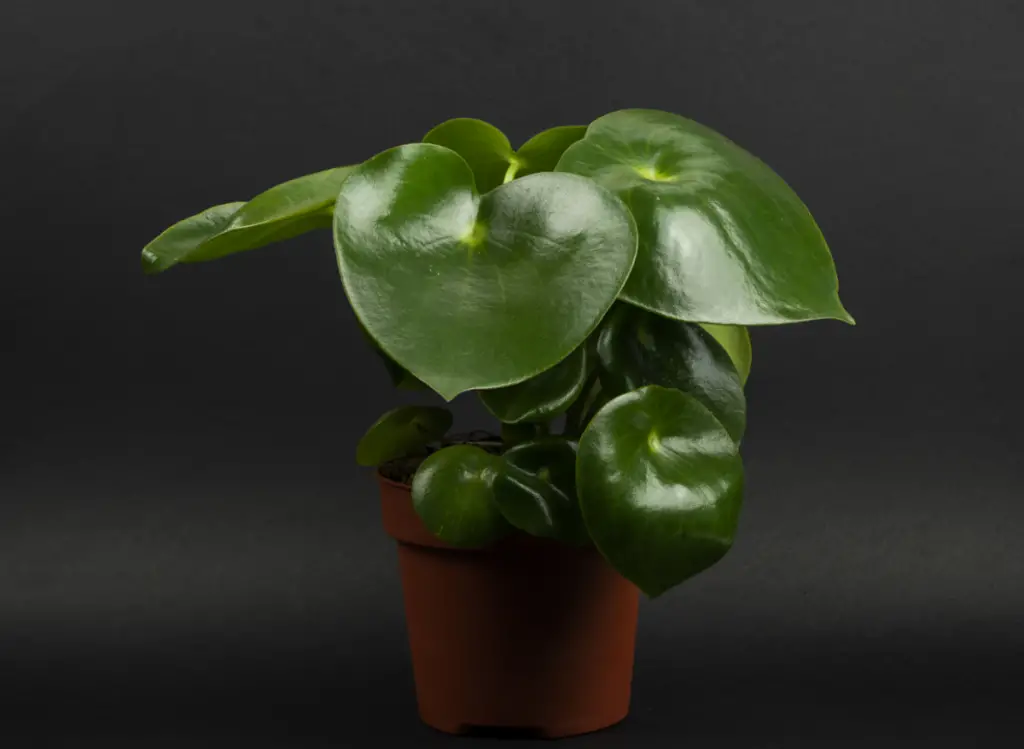
Final Thoughts
Overall, these are my favorites peperomia varieties, they are all relatively easy to care for and can be an excellent addition to your home, office, and even garden or yard.
No matter which peperomia varieties you choose, if you provide them with suitable growth conditions and they will reward with their beauty and generosity.


